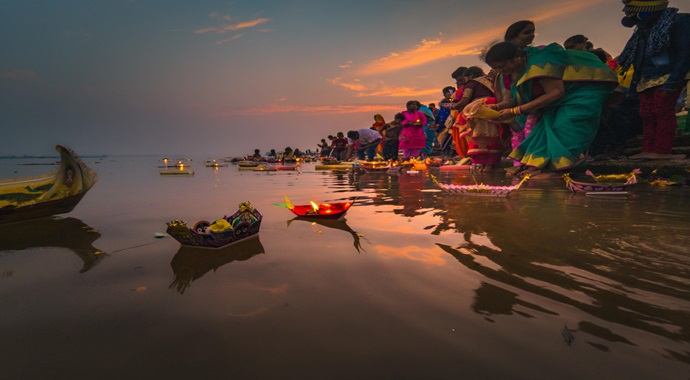Bali Yatra (Bali Jatra) in Odia language means ‘A Voyage to Bali’. And Boita Bandana, one of the most ancient maritime traditions that goes back more than 2,000 years, is a legacy of the strongest bond between Odisha and the South East Asia, and it marks the voyage of Sahasika Kalinga to Bali, Indonesia and other South East Asian territories.
This festival is home to Odisha. Though every coastal state of India were engaged in maritime activities in past, Boita Bandana festival is exclusively celebrated in Odisha. It’s because ancient Odisha was the heartland of maritime India. However, the same festival is celebrated with great enthusiasm in Thailand and other ASEAN territories as well.
Thailand celebrates Loy Krathong (to float a ‘lotus-shaped boat’), every year in November. Similarly, the South Balinese Hindu custom of Masakapam Kepesih is observed by floating a small boat having candles with the belief that the child is being sent to his original homeland Kalinga.
Odisha – A Regional Soft Power
Odisha had emerged as a Regional Soft Power much before the dawn of Industrialization in Europe.
The footprints of ancient Odisha (Kalinga) are still visible in all over Asia. For example, a tribe called Kelinga and a province named Kalinga still exist in the Philippines. Even some natives of Malayasia and Singapore are still called as Klings (Kalinga). Here the local synonym for utensils is Kantailo which resembles Kantilo (Odisha) that is very famous for traditional utensils.
Likewise, Pushpagiri University in Odisha being a global center of Academics as well as Buddhism had ensured Odisha’s excellence in Higher Education. As per a folk tale of Odisha, Nalanda University was founded by an Odia Princess named Nilendi who was the sister of Brahmadatta, the then Emperor of Kalinga. Even Nalanda was spelled as Nilendi in Mahayana Buddhist texts of China.
The Maritime history of Odisha (Kalinga) dates back to 800 BC. Odias, the Early Voyagers of the East were not only the greatest ship-builders of their time, but also were the pioneers in establishing colonies in Southeast Asian countries, especially in Bali island of Indonesia.
The Sadhaba Values
The etymological root of Bali lies in Odia language. As per an Odia tale, a Sadhaba (merchant mariners) couple of Kalinga named Balabati and Balukesha (both had the same nick name of Bali) were once on a naval exploration mission to South-east Asia and they settled down on an island where they established a colony. Later the island was named after them as Bali reflecting the confidence and trust shown by the locals of the island toward the Sadhaba couple.
The Sadhaba couple not only ruled in Bali, but also empowered the native population in all aspects of development viz, administration, education, employment, etc. through community building and participation as well as construction of Dams, Ports, Universities and so on. This was the essence of Sadhaba Values.
The name ‘Sadhaba’ is derived from Sadhu, which means Good. Sadhabas always believed in the Sadhu way of trade and administration, and thus, they were called so.
Since the establishment of the colony, the course of Odishan maritime contact with Bali has been a forever socio-cultural interaction between the two regions.
Odisha and Bali
The vocabularies of Indonesia (especially of Bali) and Odisha are noteworthy. For example, the official national motto of Indonesia is Bhinneka Tunggal Ika (Unity in Diversity) which literally translates as Bhinne hele bi Eka (in Odia), is strikingly similar to the later. Similarly, Balinese names viz. Bapa (father), Ibu (Mother), Manusa (Human) are a few to mention regarding the linguistic bridge between Bali and Odisha. The Sambalpuri style of textile weaving, an all time favourite of Odias has influenced the tie and dye weaving known as patolain Bali, where themes of Indian mythology are found. Even Balinese bridal wardrobe and crown are very much similar those of Odisha.
The Mahanadi as well as Mahendratanaya rivers of Odisha along with the Mahendra mountain are recited in Balinese verses and chanting.
In terms of cuisine, it’s our favourite Sajana Saga or Moringa leaves (maningaoleifera), a food of delicacy in both the regions. Lots of cakes prepared from rice-flour known as Manda-pitha,Enduri-pitha in Odisha are also popular in Bali. Pick any ancient shrine in South East Asia, one can easily notice the influence of Odishan Architecture. The influence is so huge that anybody can find it throughout Indonesia and especially in Bali.
Odisha was crucial in the spread of Buddhism across Asia. Interestingly in the daily rituals of a Buddhist priest, God is addressed as Jagannath. In Odishan tradition Adi Buddha is referred as Jagannath. In Bali, Siva was also worshipped as Jagannath. Thus, there was rapprochement between Siva, Buddha and Jagannath in Bali and this influence basically came from Odisha.
The Balinese society also celebrates festivals like Sivaratri, Sarawvati Puja or Odalon Saraswati and Durga Puja or Page Wesi. Another important aspect of Odisha’s Bali-connection is the observation of rituals. Like in Odisha, ancestor worship is prevalent in Bali. The rituals of the funeral ceremony like shaving of heads and feeding the Brahmans on twelfth day are found in Odisha as well. If the epic tale of the Ramayana could travel from Ayodhya (India) to Bali (Indonesia), it was Odisha that did act as a connecting bridge between the above two far away locations.
Odisha’s Global Presence
From the Chinese to the Romans, Kalinga’s maritime glory was enormous. Kalinga’s Rome-connection has a lot of historical significance which is not yet studied thoroughly. Periplus of the Erythraean Sea (first century CE) and Ptolemy, the Greek geographer of 100-50 CE, mention about the ports of Odisha and maritime contacts with the Roman world.
Kalinga is mentioned in the historical works of both Indian as well as foreign scholars viz. Kalidasa, Megasthenes of Greece, Fa Hien and Hiuen Tsang of China, etc. Such was the dominance of Kalingas that in ancient times the Bay of Bengal was called Kalinga Sagara. Kalinga Sagara was renamed to Bay of Bengal by the British. Kalingan vessels were called Snakes of the Sea during Ashokan era. Also there was one of the strongest Navies of that era maintained under Kalinga, as maritime trade always comes with a strong security force. And Kalinga was no exception. Ancient texts say that Chilika was a hub of shipbuilding and global maritime commerce during the reign of Kharavela who lorded over the Kalinga Sea as Sagaradhipati. Our Sadhabas, comprising of voyagers, traders, architects, engineers, industrialists, investors, leaders and entrepreneurs were truly the carriers of the Great Kalingan Civilization.
Modi Ji’s Vision for Odisha
Golden beach in Puri became of the only 8 beaches in India to have bagged the coveted Blue Flag Certification.
We must cherish, celebrate and learn from this glorious tradition of Odisha’s history as we craft the scaffoldings of a New India. However, the time has come again for the ports of Odisha to be the harbinger of economic growth and a fulcrum of global trade and commerce.
Prime Minister Narendra Modi chose Paradip as the Vikasdeep of his Purvodaya vision for the development eastern India and took forward the efforts of former Prime Minister Atal Bihari Vajpayee who laid the foundation of Indian Oil Paradip Refinery during the NDA government in May 2000.
In the past eight years, Paradip Port has grown by leaps and bounds to emerge as the Pride of Odisha and is one of the only two ports in the country capable of handling over 100 million tonnes of cargo. Paradip Port boasts of 16 berths and 3 Single Point Moorings (SPM), which is the largest crude handling points in the world. It is the largest dry bulk handling port in India and a major gateway for coal exports to power plants in South India, coal imports for steel plants in Eastern India and seafood exports to Japan.
Under the Sagarmala scheme, 46 projects are being implemented in Odisha at a cost of Rs. 57,379 crores which are focused on port modernization, port connectivity, port-led industrialization and coastal community development and will transform Odisha’s coastline into an epicenter of economic development and international value chains. Recently, Union cabinet has also approved Deepening and Optimization of Inner Harbor Facilities at a cost of Rs. 3,004.63 crores.
Apart from the expansion of Paradip Port, the LNG terminal at Dhamra, Astaranga Port, a riverine port on Mahanadi River in Kendrapada district, and a riverine port on Subarnarekha river development of inland waterways is also being carried out. The advantageous natural navigability of Odisha’s riverways can be further improved through dredging.
Anchor industries and companies are needed for the development and operations of new ports in Odisha and optimal utilization of riverine and seaport area. Further potential for port-led Blue Economy will be unlocked with the multi-modal rail, road and air linkages with sea and riverine port for transport of minerals and goods at much lower logistics cost. Shipbuilding industries can also be encouraged along Odisha’s coast. Further development of seafood farming and pisciculture, along with harvesting of bio-resources such as algae and seaweed for exports.
Immense untapped potential for coastal tourism in Odisha, as evinced by the success of eco-tourism. Under the Swadesh Darshan scheme, the development of Gopalpur, Barkul, Satapada and Tampara in Puri district of Odisha as Coastal Circuit is being carried out at a cost of Rs. 76.49 crores. Indeed, Paradip is slated to emerge as the Mumbai of eastern India and recreate the lost maritime glory of Kalinga. Paradip will not only be the Vikasdeep of Narendra Modi’s Purvodaya as an international trade and industrial powerhouse but also the Bhagyadeep of Nua Odisha with world-class living facilities and job creation.
In the past eight years, the lost maritime glory of Odisha is being rebuilt under the visionary leadership of Hon’ble Prime Minister Shri Narendra Modi. There are massive investments all along the coast which would be a game-changer for the industrial, trade and tourism sector in Odisha.
The highlight of these #OdishaMODIfied projects is of 451 KM Coastal Highway stretching from Digha to Gopalpur which hugs Odisha’s coastline and is among the grandest infrastructure projects ever undertaken in the State. The Coastal Highway will pass through six districts and hundreds of villages bringing about a dramatic transformation in the lives of lakhs of Odias. The Coastal Highway will give an unprecedented impetus to coastal tourism in the State and provide vital commercial channels throughout its 451 KM route. Numerous resorts, restaurants and beaches will lead to massive tourist foot falls and generate thousands of jobs. The coastal highway will also provide a vital infrastructural agency during rescue operations in times of natural calamities such as cyclones.
The time has come for the rising sun to herald the dawn of a New Odisha under the leadership of the Narendra Modi-led BJP government. Modi Ji does have a vision for Odisha to make it a frontline state in India’s mission to become a Blue Water Navy. Modi Ji is the first Statesman to understand the rationale behind India as a Global Super Power by 2047 – Odisha’s share in Indian Naval domain will undoubtedly ensure the revival of maritime glory of the State as well as the Nation.



